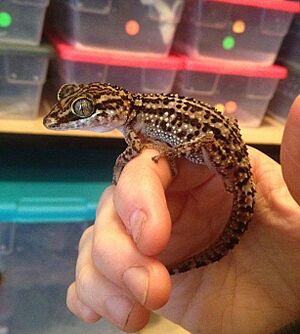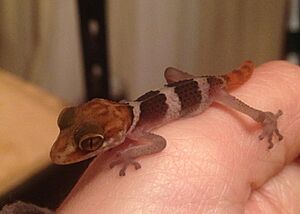Paroedura lohatsara facts for kids
Quick facts for kids Paroedura lohatsara |
|
|---|---|
 |
|
| Conservation status | |
| Scientific classification | |
| Genus: |
Paroedura
|
| Species: |
lohatsara
|
The Paroedura lohatsara is a type of small-to-medium-sized gecko that lives only in northern Madagascar. You can find these geckos on just one mountain range there. They grow up to about 6 centimeters (2.4 inches) long. Their bodies are brown with black spots, which sometimes connect to form stripes. Young geckos have wide black and white stripes, but these change as they get older. This gecko is mostly active at night (this is called nocturnal). It lives on the ground, on rocks, and in the lower parts of trees. Because it lives in a very small area and its forest home is being destroyed, this gecko is listed as critically endangered. This means it's at a very high risk of disappearing forever. Some of these geckos are kept in zoos or by special collectors in the United States. They could help save the species if it disappears from the wild.
Contents
What Does It Look Like?
Young P. lohatsara geckos have brownish heads. Their bodies show clear black and white stripes, and their tails are striped and orangey. As they grow up, their colors change. The stripes on their bodies break apart. They become mostly light yellow with black spots.
Sometimes, these spots still look a bit like stripes. But they often shift to more lengthwise patterns. Adult geckos of this species usually grow to be about 13 to 15 centimeters (5 to 6 inches) long.
Where Does It Live?
This gecko is originally from northern Madagascar. It has been seen in a place called Montagne des Français. It lives at heights between 140 and 320 meters (460 to 1050 feet) above sea level.
These geckos live in old, untouched forests. They do not seem to do well when their forest home is damaged. This means they cannot easily adapt to changes like trees being cut down.
How Does It Behave?
Even though these geckos are mostly ground animals, they can climb. People have seen them on rocks and tree branches up to 2 meters (6.5 feet) off the ground. In captivity, their toe pads help them stick to the sides of their tanks. This is especially true when they are young.
As they get bigger and heavier, they seem to prefer climbing on plants and other things. Both young and adult geckos are active at night. This is why they are called nocturnal animals.
Reproduction
These geckos become old enough to have babies at about one year of age. Male geckos have a small bulge near their tail, which females do not have. This difference helps tell them apart.
Why Is It Endangered?
The P. lohatsara gecko is currently listed as critically endangered. This means it faces a very high risk of becoming extinct in the wild. It is not protected by a special international agreement called CITES.
This gecko lives in a nature reserve. However, its home is greatly threatened by people moving into the area. This often leads to trees being cut down, mainly for wood. In the United States, some reptile experts are working to help these geckos have babies in captivity. This effort aims to create a safe group of geckos. This could help protect the species from disappearing completely.
Caring for Them in Captivity
A tank that holds about 38 liters (10 gallons) can be used for one gecko. Or, it can house a pair during the time they breed. The warm part of the tank should be about 29 to 32 degrees Celsius (85 to 90 degrees Fahrenheit). The cooler part should be about 21 to 24 degrees Celsius (70 to 75 degrees Fahrenheit).
It's good to spray the tank heavily with water in the morning and afternoon. This helps the geckos stay hydrated. The humidity should be high, around 80-90%, when you mist. It can drop to 45-50% in the middle of the day.
The bottom of the tank can be covered with a mix of peat moss and potting soil or sand. You should also put several pieces of cork in the tank. These geckos are quite shy and like places to hide. Female geckos lay two eggs at a time. These eggs can hatch at 27 degrees Celsius (80 degrees Fahrenheit) and 80% humidity. The eggs usually hatch after 90 to 100 days.



